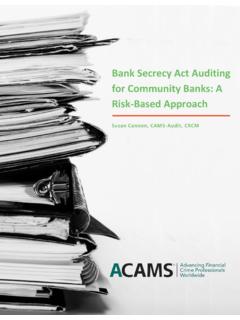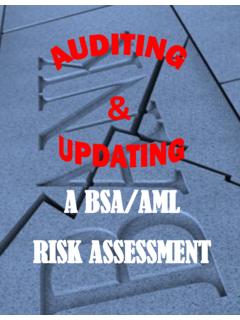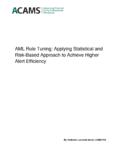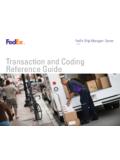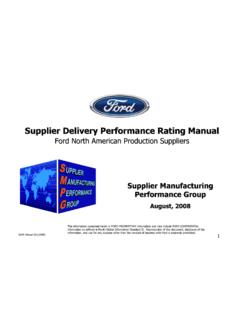Transcription of AML Audit and Correspondent Bank Transaction …
1 AML Audit and Correspondent bank Transaction monitoring for Diamonds Written By: John McCormick, CAMS- Audit 2 Table of Contents 1) Types of Correspondent bank monitoring Systems That May Alert illegal Transaction ( Diamonds) Activity 2) Enforcement Actions of the Global Diamond Trade 3) Correspondent Banks Challenges to Monitor Diamonds in the Current Regulatory Environment a. Account Secrecy b. Know Your Customer (KYC) c. Current Correspondent bank monitoring Scenarios 4) AML Internal Audit Roles: I. AML technology implementation II. Data integrity verification III. Tuning activities IV. Model Validation V. Confirm system and business reliability 5) OCC Model Risk Management 6) AML Internal Audit Roles that can Enhance Correspondent bank Transaction monitoring of Diamonds: I. AML technology implementation II. Tuning activities III. Model Validation 7) Conclusion 3 Transactional monitoring systems are limited in their effectiveness to identify illegal Transaction activity.
2 A weak link in the financial system exposes all banks and financial institutions to this illegal activity. Most recent are charges by Belgian authorities to HSBC for their lack of compliance for the better part of 10 years1 (1999 to 2011) to have allowed individuals and businesses to dodge taxes, hide cash and transport untraceable money that would include diamonds. 1) Types of Correspondent bank monitoring Systems that May Alert Illegal Transaction ( Diamonds) Activity Transaction monitoring systems for the banking industry continue to evolve. Standard vendor models can be customized to screen large populations of activity that include cash, checks and wires. Alerts can be generated when thresholds are broken for analyst review, and simple models create alerts based on set thresholds or a word match from a watch list. Advanced models include abnormal transactional activity for the period of which fuzzy character recognition techniques, sequential numbering, and in-depth wire reviews of multiple intermediaries ( , bank customer s customer) provide quality alerts.
3 The ability of Transaction monitoring model customization allows an institution to produce quality alerting for review. Institutions also have moved toward fully automated alerting and controls that remove manual overrides of the alert generation or review process. Correspondent monitoring systems continue to strengthen across the financial industry. However, financial innovation creates more challenges as new products are introduced globally. Electronic banking and new financial products will continue to contribute to transactional volume growth and each present unique challenges for institutions to monitor Transaction activity. The ability to monitor effectively will take time to develop, leaving a short-term opportunity for illegal transactional activity not currently monitored by the financial institution. 2) Enforcement Actions of the Global Diamond Trade Past enforcement actions of the global diamond trade has been limited.
4 Organized crime has the ability to utilize precious gems as a substitute for currency. Diamonds in particular are attractive, since historically, they maintain their value and are easy to move across countries virtually without detection. Diamonds are personal property, and do not have to be declared as part of a cross-border currency Transaction . They do not have to be subject to confiscation by law enforcement and no currency exchange is required. Diamonds as an alternate currency has more appeal than precious metals ( , gold and silver) since they have more price volatility and do not maintain a steady value. 1 4 On April 3, 2014, federal prosecutors announced that while HSBC Holdings has made improvements to its anti-money laundering (AML) system, much work remains for the bank as part of its $ billion deferred prosecution agreement with the Department of On February 9, 2014, Belgium, center of the world diamond trade, charged HSBC s Swiss Private bank with fraud with many dealers under investigation around the 3) Correspondent Banks Challenges to Monitor Diamonds in the Current Regulatory Environment a.
5 Account Secrecy Over the past few years, the financial industry has seen many offshore accounts within tax havens to be uncovered and closed mainly due to the Organization for Economic Co-operation and Development (OECD) tax haven list and the Foreign Account Tax Compliance Act (FATCA). I. FATCA is the federal law that requires persons, including individuals living outside the , to report their financial accounts held outside the , and requires foreign financial institutions to report to the Internal Revenue Service (IRS) information about their clients. FATCA was enacted by Congress to make it more difficult for taxpayers to conceal assets held in offshore accounts and shell corporations to help recapture federal tax revenues. FATCA is a portion of the 2010 Hiring Incentives to Restore Employment (HIRE). 4 II. OECD produces a list of countries that are known tax havens. Past identified tax havens have included Antiqua and Barbuda, Belize, Bahamas, British Virgin Islands (BVI), Cayman Islands, Cyprus, Guernsey, Gibraltar, Isle of Man, Jersey, Liechtenstein, Malta, Mauritius, Monaco, Panama, Samoa, San Marino, Seychelles, and Turks and Caicos.
6 Current identified tax havens are Nauru and The OECD also developed new standards to force tax havens to disclose the names and fortunes of tax dodgers. Unfortunately, wealthy individuals and businesses still have investment vehicles at their disposal that are not yet transparent and do not have effective oversight. These vehicles include: 2 3 , 9 Feb 2015 4 5 The Wolfsberg Trade Finance Principles, 2011, Pages 3 - 4 5 I. Hedge funds This industry continues to grow with the current size of $ trillion across 11,000 funds globally,6 and enjoy global tax advantages. II. Structured investment vehicles (SIVs) SIVs may be set up to eliminate the identification of a politically exposed person (PEP) in the ownership tree of the entities structure, while at the same time tax payments are optimized ( , minimized) within the current domicile s tax structure. III. Trade finance Trade Finance principles7 have been put in place to define standards for the control of AML risks associated with trade finance activities, but risks still remain, especially if both parties are controlled by the same This includes over-invoicing, under-invoicing, multiple-invoicing, short shipping, over shipping, deliberate obfuscation of the type of goods and phantom shipping.
7 B. Know Your Customer (KYC) KYC guidelines include a Customer Identification Program (CIP), customer due diligence (CDD) and enhanced due diligence (EDD), to identify AML risk. Institutions should conduct a risk-based approach9 that includes country risk, customer risk and services risk. EDD may be required for services that include international Correspondent banking services, international private banking services and services that involve banknotes and precious metals trading and A strong onboarding process and periodic assessments reduces illegal activity at each institution, but the presence of gatekeepers such as accountants, lawyers, and wealth management professionals creates the ability to circumvent tax laws legally ( , tax loopholes) or by various illegal means. The ability of these gatekeepers to understand client onboarding and Transaction monitoring procedures and standards, allows them the knowledge to provide tax optimization services that may include tax evasion and illegal transactions for wealthy clientele.
8 C. Current Correspondent Banking monitoring Scenarios Leading AML Transaction monitoring software vendors provide similar types of monitoring functionality with the ability to customize parameter settings for optimal Transaction coverage. Scenarios include, high-risk geography, patterns of funds, outliers and rapid movement of funds. Watch list functionality compliments these customized strategies to detect suspicious transactional activity for further investigation. Transaction monitoring scenarios provide broad coverage to effectively monitor for suspicious Transaction activity. Unfortunately, monitoring scenarios will have limited 6 , 31 August 2014 7 FATF s Best Practices paper on Trade Based Money Laundering , June 2008 8 The Wolfsberg Trade Finance Principles, 2011, Pages 3 - 4 9 Wolfsberg Risk-Based Approach Guidance , 2006, page 2 10 Wolfsberg Risk-Based Approach Guidance , 2006, page 6 6 results on the wealthiest parties who have financial resources to hire gatekeepers ( , lawyers, accountants, wealth advisers) to help navigate legal restrictions and tax codes to optimize wealth by legal or illegal means.
9 The ability global and investment banks have to trade over-the-counter (OTC) currency and commodities allows clients the opportunity to utilize this OTC infrastructure for a diamond platform to move money globally. For example, gold has a standard contract trading on the NY COMEX division of the Chicago Mercantile Exchange (CME) futures exchange. The standard size of the gold contract on the futures exchange is 100 ounces. If the current price is $400 per ounce, then the contract value is worth $40,000. Currently, the price of gold is $1,200 per ounce due to gold price volatility. Clients have the option to originally purchase gold in the cash market. An OTC dealer will make a bid/ask quote to the client. Once the client buys/sells the cash gold, they have the ability to move this cash trade to the futures exchange. This can be executed by a swap trade, which would be a cash to forward swap or an exchange for physical (EFP) Transaction . This is not important for this paper, but this type of OTC metals pricing ( , gold, silver) can also be applied to diamonds within the same OTC structure.
10 In the OTC market, global gold dealers are trading partners ( , counterparties). To create this similar structure, diamond dealers become trading counterparties across the world and can agree to a standardized contract size ( , $40,000). This dollar amount is also important since it is a smaller dollar contract amount and stays away from a large Transaction size for monitoring . Contracts among dealers can be settle by the diamond delivery equivalent of $40,000. Unlike a standardized metal s contract ( , gold equal to 100 ounces), the diamond OTC contract can be set at $40,000. Diamonds have a history of holding a more stable value then other metals in the past, especially due to the past monopoly of DeBeers. This monopoly provided an excellent control to minimize price fluctuations and risk. The long standing and effective control over the supply of diamonds in the market place (supply curve) allowed the ability to avoid price volatility that would occur in a normal supply and demand ( , gold) marketplace.
